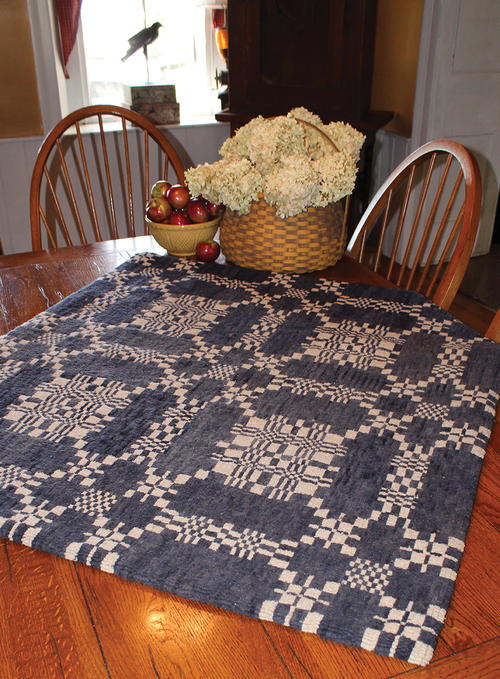From Woven Coverlet to Hooked Rug
A rug hooker's journey

Antique Coverlet #2, 40" x 45", #8-cut wool on linen. Designed and hooked by Julie Thomas, The Old Tattered Flag, Evans Mills, New York, 2016.
Have you ever been out and about and seen something fascinating and said, “I want to hook that!” It happens often with me. I once turned a piece of ironwork that adorned a shop window into a hooked rug design. I’ve also adapted a wonderful folk-art quilt from the early 1800s and a rock path into rug designs. It’s our nature as creative people to be inspired and see how we can blend everyday things into our craft. When you become a rug hooker, you see things differently—you notice how many shades of green are in a leaf, you notice the bumps on a cucumber and think of how you will hook it to get that look.
Inspiration is everywhere!
It’s only natural for rug hookers to love other forms of fiber arts and textiles. I am obsessed with the designs and patterns of antique textiles, quilts, lace doilies, and coverlets. I appreciate the pristine “fancy” coverlets with names or dates woven into them and I love the complex woven coverlets, but I find that I am most drawn to the basic two-color woven coverlets.
I appreciate learning about the history of a textile, of course, but for me it’s not necessary. When I love a design it’s usually because I “feel” it. Do you know what I mean? You know that feeling you get when you see something and it physically affects you?
Though I was curious about the origin of coverlets I never delved into the subject much. I knew from discussions overheard in antique shops here and there that most simple coverlets were primarily woven by the homeowner in the early 1800s out of necessity. Coverlets were made for warmth and were used on the beds. I read that the average, simple coverlet could take as little as 6 hours to make, but that did not include the growing time of the flax that was used to create the linen “base” and then the raising and shearing of the sheep, and carding and spinning the wool for the weaving.
Read NextPainted Landscapes



